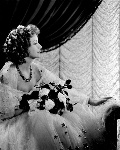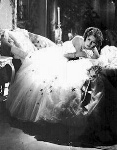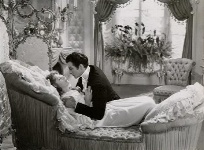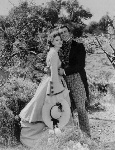Camille: Revisiting Garbo's Greatest Performance

"Camille," directed by George Cukor at MGM, is considered to be Garbo's greatest screen performance.
"Camille" will be shown at the UCLA's James Bridges Theater, Melnitz Hall, on April 24, as part of a Centennial Tribute to Greta Garbo. The month-long event kicks off on Thursday, April 7, at the Academy of Motion Pictures Arts and Sciences, though most of the screenings are at UCLA. For tickets, call: (310) 247-3600.
If George Cukor regretted being unable to shoot his screen adaptation of "Romeo and Juliet" in Italy, he felt the same way about not filming "Camille" in Paris. Garbo was under contract for two more pictures, and Cukor was given a choice: "Anna Karenina" or "Camille." He chose "Camille," guiding Garbo to her greatest performance in the role of Dumas' doomed heroine. In "Camille," he brilliantly created a psychological portrait of a victim trapped in her social milieu. "Camille" represented another achievement: It was Cukor's first costume film that had the right look.

Selznick was apprehensive about his first venture with Garbo, due in part to her stature, and, more to the point, the commercial disappointment of her historical film, "Queen Christina." Initially, he was inclined to film "Dark Victory," provided he could purchase the Broadway play at a reasonable figure and get Philip Barry to write the script. Cukor agreed that "Dark Victory" was a better vehicle for Garbo than "Anna Karenina." Assuring Garbo that Cukor would put his best efforts into making a fine film of "Dark Victory," Selznick asked for her permission to switch from "Anna Karenina." But in the end, he decided against doing the picture.
Over the years, Cukor had seen Garbo at MGM, but he had not formally met her. He was finally "treated" (as he put it) to the divine Garbo in l935, though his first impression was not great. He found Garbo to be nice and sweet, but devoid of humor and rather pretentious. Garbo was also depressing, as if she were carrying all the sorrows of the world around her. Real lesbians, he told Hugh Walpole with unusual candor, was a little heavy-handed and so goddamned noble. Cukor would make jokes about the suffering that Garbo projected onscreen, imitating to his friends her famous line, "I want to be alone!"
Walpole was anxious to know how Cukor was getting on with the Swedish star. Was she rude to him? Other directors who worked with Garbo have all recommended being tough with her. Teasing Cukor for being too gentlemanly, Walpole feared Garbo would bully him.
Considering the subject matter of "Camille," censorship problems were expected. The Production Code office decreed that, "the heroine is definitely an immoral woman," and demanded that the story be cleaned. Stipulating that there should be no "courtesans" in the film other than Marguerite, they recommended that Olympe be married, instead of being a mistress. They also suggested that Marguerite indicate she would not resume her life as a courtesan after breaking with the Baron. Cukor was at once bemused and outraged, when the censors wished to inject a stronger note of repentance and regeneration.


"You have put too much emphasis," Breen wrote, "on the point that living as a mistress is a highly profitable enterprise, wishing Cukor would tone down the fact that Marguerite goes about the business of procuring a master in a cold-blooded way. Breen also thought it would be better if Marguerite did not go to Armand's apartment at midnight. Why not play this scene in the cafe? And was it necessary to show Armand living with Marguerite in the country?
Cukor knew that "Camille" was a hackneyed piece of theater, which could only be elevated by an extraordinary portrayal of the central character. With Garbo, it was the happy meeting of a gifted actress and the perfect part. A reigning star in Hollywood for twelve years, Garbo had made 20 films, but Camille became her most publicized performance. For the first time, the press touted, an actress has successfully challenged the immortals of the theater, Tallulah Bankhead, Ethel Barrymore, and Eva Le Galienne, who had played Camille on stage. Cukor also knew that comparisons would be inevitable with Norma Talmadge, Nazimova, and Theda Bara, who have tried their luck with the part on screen.
For Cukor, the movie's most false note was how easily Armand's father talks Marguerite out of seeing his son. It was a difficult scene for modern audiences to comprehend--not so much the dialogue as the situation itself. "Armand is the world's worst part," Cukor said, "the only way for it to work was to cast a young man in the role." Regrettably, Armand was usually played by middle-aged actors, and one can't forgive an older man for being so foolish and weak.
Though it was not his idea, Cukor was satisfied with the casting of Robert Taylor as Armand. Handsome and six years younger than Garbo, he made Armand more convincing. Taylor also had the advantage of projecting a romantic image--for many viewers, it was the most credible Armand they've ever seen. A leading man, Taylor possessed classical beauty and a great profile. "One practically forgets the meaning of real beauty," Cukor said, "or what true beauty should really represent."
Under Cukor's direction, Garbo played her most demanding role: Camille consisted of 156 scenes, of which she had 57. Cukor's challenge was to provide continuous stimulation for her. "With Garbo," he said, "you must make a climate in which she trusts you. You watch carefully what she's doing and you make suggestions, but you let the impulse come out of her."
Indeed, after seeing the rushes of the first few days, Thalberg said: "George, she's awfully good, she's never been so good." "But Irving," Cukor said, "she's just sitting in a theater box." "She is relaxed and she's open," the producer said. That night, running some of Garbo's previous movies, Cukor realized what Thalberg meant: there was a new, unguarded quality about Garbo, never shown before.
Cukor found Garbo to be a most imaginative actress--her performance was built of many small, inventive gestures. For example, the way Garbo responded when Taylor says, "No one has ever loved you as I love you!" "That may be true," she says with a casual smile, "but what can I do about it?" When Garbo bursts out into tears, it isn't just an actress crying.


Garbo's previous tendency to flatness and lugubrious drone was absent from "Camille." Revitalized by the role and reenergized by Cukor's meticulous direction, she went beyond her vocal limitations. And her deathbed scene was truly heartbreaking. Cukor's mother was dying just before shooting began. While visiting her, he noticed certain facial expressions and gestures, which he used in Camille. "Part of me is always clocking something I can use," he said about his habit of always observing. It was Cukor's idea, in fact, that Garbo plays her death scene in a whisper.
Not subscribing to the view that Garbo's main asset was her "physique," Cukor allowed Garbo to register deep feeling and thinking on screen. Garbo was distant--she categorically refused to speak to Robert Taylor during the shoot. Not because she didn't like Taylor--she wanted to safeguard her love for the personality he portrayed. In this fashion, she retained the illusion that Taylor was really Armand, her uncompromising lover. Garbo knew that if they socialized, Taylor would become just another actor.
One of the film's most erotic scenes--when Garbo and Taylor convey passion and impatience for each other--was filmed without any instructions from Cukor. Cukor let Garbo use her own ideas. Garbo just leaned over, but her body didn't touch Taylor, and gave him small kisses all over his face. In a scene, where Garbo had to walk through a theater lobby, Cukor instructed her to walk slowly, so that the men would have time to examine her. But instead, Garbo walked very fast. She knew instinctively that a beautiful woman does not have to walk slowly to get attention.
"Garbo has a magic that can't be defined," Cukor said at the time. "She is a rare creature who touches the imagination and no one will replace her," he added after her untimely retirement. "She submits herself to the camera, and retains her privacy before it." For Cukor, Garbo's greatest, undecipherable quality was her mystery onscreen: "Garbo had this rapport with an audience. She could let them know she was thinking things, and thinking them uncensored."
Cukor admired the gambling scene, where Garbo drops her fan and the Baron De Varville makes her pick it up. Garbo makes a remarkable movement, but she doesn't kneel to pick it up--bending down would surrender her dignity. Instead, she leans sideways in a most natural way. In the scene where she gives up Armand, Garbo surprised Cukor when she slowly sank to her knees and threw up her arms.
Garbo was a most pragmatic actress: She would leave at a certain hour but not because she was indifferent. After long hours on the set, she would get nervous, and she wanted to look fresh the next day. And there were certain things Garbo demanded, conditions under which she worked well. Privacy was one of them. She didn't like people standing and staring at her. "If visitors come," Cukor said, "I always move the actors away from their view; most actors find it disconcerting.
Cukor once asked Garbo, "Why do you mind people looking at you?" "When people are watching," Garbo answered, "I'm just a woman making faces for the camera. It destroys the illusion."
Garbo didn't talk an awful lot about what she was planning, because that would lose the magic when she actually performed. Instead, she held it in. Cukor would rehearse her in the mechanics of the role, but often when the cameras were turning she would add something totally new. Cukor also learned that Garbo was very good in the first five or six takes, but then she would lose her freshness. Unlike most actors, Garbo never watched her rushes. Challenged by Cukor, she simply said: "I have some idea of what I am doing, and every time I see it it falls so short that it throws me."
In later years, accused of perpetuating Garbo's mystery, Cukor's response was "Bullshit." Offscreen, Garbo was actually a simple girl. Once Hungarian playwright Molnar (The Guardsman) asked Cukor to arrange for a meeting with Garbo. Garbo went to see him at the Plaza Hotel and they talked about doing one of his plays. Their meeting was so awkward that the disappointed Molnar complained to Cukor that Garbo was dull.
Cukor immersed himself in the period of Camille, researching the sets and costumes. The "Can Can" dance, meant to evoke Toulouse Lautrec, was an approximation of the dance Alexander Dumas saw, and was later forbidden by the Paris police. Cukor had many discussions with Bill Daniels, Garbo's favorite cinematographer, about the lighting. They used a shallow depth of field and lush, romantic lighting. Karl Freund completed the cinematography when Daniels got sick, but the film maintains a coherent look.
The film's music had an exceptionally emotional impact. Cukor instructed Henry Daniell, as the nasty Baron De Varville, to play the piano louder and louder when Armand is ringing the doorbell and Garbo stands agonized beside him. He chose to end the scene that way. Cukor also introduced a new scene in Camille where Henry Daniell and Garbo were to laugh. They were both worried, because neither laughed easily on screen.
Cukor thought the scene at the casino was lacking something, even though it had been planned and approved by him. It was getting late, 6 o'clock at night, and they were going to shoot on the set the next morning. But to his surprise, at 9 am the next day, there was a huge statue of the Goddess of Chance on the set; it was precisely what was needed. Resources like that made life much easier for directors during the studio system.
Thalberg died in September in the midst of the work on Camille. On the last day of shooting, October 27, l936, MGM's Eddie Mannix asked Cukor: "This is Irving's last picture. Is there anything you can do to improve it?" "There's always something one can do," he said, asking for three more shooting days to make some fine points.
The loss of Thalberg was so heavily mourned that the LA premiere of Camille became a veritable regatta wake, opening up the corral for celebrity demonstration. Even Garbo showed up--not a minor achievement. Thrilled by the results Camille, Norma Shearer told Cukor: "I think it is something to be really proud of, I am so grateful for all you contributed to Irving's life."
The word of mouth of Camille was so good that it alarmed Cukor, fearing its potential effect on reviewers. "Now you'll go to see it," he told a friend, "and just sit there and grit your teeth and wonder why any one should have said so much about it." Cukor took the film to NY and showed it to a distinguished audience that included Tallulah Bankhead and Noel Coward. At the end of the screening, with some viewers still sobbing, Coward got up and announced that Garbo gave "the finest performance ever put on screen." He declared it in such way that his words had weight.
MGM announced "Garbo Talks" for Anna Christie and "Garbo Laughs" for Ninotchka--now they could publicize Camille as "Garbo Acts! Garbo's performance was refreshingly ironic: Her Camille was too intelligent for the character's frivolous life, too generous for the historical circumstances. But it was consistent with a film that presented a romantic view of a courtesan life.
Garbo was so good that Cukor violated his habit of not seeing his movies more than once; he actually saw Camille four times. Arguably her greatest screen performance, Garbo won a well-deserved Oscar nomination and the New York Film Critics Award as best actress of the year. Garbo was obviously pleased, but she never said a word to Cukor, which upset him very much.
Most of the reviews talked at length about Garbo's splendid work. "Through the perfect artistry of her portrayal," wrote Frank Nugent in the N.Y Times, "a hackneyed theme is made new again, poignantly sad, hauntingly lovely. Garbo has interpreted M. Gautier with the subtlety that has earned her the title, 'first lady of the screen.'"
When "Camille" came out, Cukor was not given any particular kudos for either the film or Garbo's work. Some critics believe that it's time "Camille," often called Garbo's finest picture, should also be recognized as Cukor's finest picture.
If you want to read more about Cukor's work with Garbo on "Two-Faced Woman," which will be shown April 17, please read my biography, George Cukor, Master of Elegance (William Morrow, 1994).